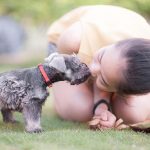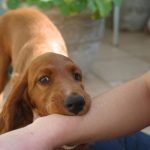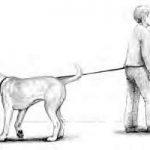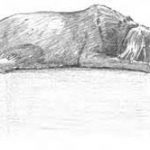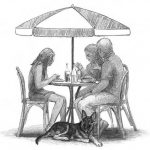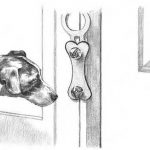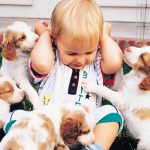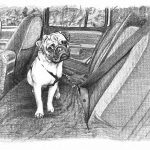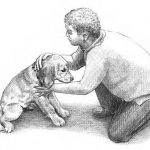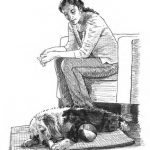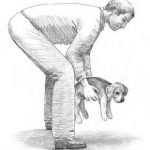Kids and Puppies

In This Chapter
- Helping your kids and puppy bond
- Discouraging your puppy from nipping and tugging
- Overcoming Sibling Rivalry Syndrome
One of the hallmarks of my childhood was my dog, Shawbee, who was a Husky-Shepherd mix. She was my constant companion, waiting for me at the bus stop, hanging outside the church while I took ballet lessons, sharing my ice-cream cone on a hot summer day. Nowadays, dogs and kids rarely have the freedom to bond this way. The world today is different from when I was a child. We have computers. Most communities have leash laws. Dogs left outside are stolen. People are even more dog phobic. Unfortunately, times have changed, and new problems are cropping up.
Encouraging Positive Interactions between Kids and Pups
Tip
To bring out the best in your household, be mindful of where your children are emotionally and what your puppy is capable of at the time. Your child and puppy will be most cooperative when they’re understood and you stay positive. In this section, I give you some suggestions.
Use positive catchphrases
Remember
Kids don’t respond well to nagging. Phrases such as “Don’t do this” and “Don’t do that” have a tendency to go in one ear and out the other. Like dogs and puppies, kids respond better to a more positive approach.
– “Four paw rule”: This catchphrase helps the kids remember not to pet Rex until all four paws are planted on the floor. And, this catchphrase sounds a lot better than “Stop calling the dog on the couch.” (At which point, I would defiantly do exactly what you said not to do, if I were the kid.)
– “It looks like rain”: When the kids come in from school, have them “look for rain” until your puppy calms down — that is, tell them to cross their arms in front of their body and look to the sky (see Figure 8-1). You can also have your kids look for rain when the pup jumps into their laps for attention. This body language will communicate calmly that jumping is an ineffective way to interact.
Tip
If your puppy is just too big for the “looking for rain” technique to be effective, use a spray bottle filled with water or a water-vinegar mix to discourage your pup from jumping. Instead of aiming at his face, however, spray the mist in between your child and the puppy.
– “Kisses”: This trick is fabulous. Rub a frozen stick of butter or peanut butter on the back of the kids’ hands, have them extend their hands, and together instruct “Kisses.” The trick not only teaches your puppy to kiss a hand that reaches toward him, but it also discourages nipping.
– “Thumb clip”: This is a kid’s version of bracing (see Chapter Life from His Paws: Understanding Your Puppy’s View of the World). Show your children how to clip their thumb over your puppy’s collar and fan their fingers across his chest. This technique is a good way to discourage jumping and calm your puppy down.
Play groovy games
Warning!
No tug of war, please! Even though your puppy will bait your children and your kids will like the game, discourage it. Your puppy must learn that when hands are touching an object, teeth let go — period. Tug of war can lead to serious consequences because your puppy most likely won’t be able to distinguish between a stuffed toy or leash and an item of clothing (see Figure 8-2).
Breaking the cycle of tug of warA 6-year-old girl was strangled to death after she was sent out to play with her 3-year-old Golden Retriever. The Golden Retriever was overstimulated in play and tugged on the girl’s scarf until she suffocated and died. Even though no words can express the family’s sorrow, there is a moral to this story: No tug of war. Your dog must learn never to pull on an object that is worn or held by a human. Puppies love to tug and wrestle as much as, or more than, children do: Tugging is an ageold developmental game of control and power. It has, however, no place in a child-friendly household. Kids can get easily overwhelmed or overpowered by a puppy who can’t differentiate between a toy, an article of clothing, a cherished stuffed animal, a doll, or hands and fingers. If your puppy is a tugging addict, try the following:
|
Remember
Monkey see, monkey do. You are your children’s best example. If you remain calm and structured with your puppy, your child copies you. If you’re frantically confused or you encourage rough play, your child copies that, too. Inspire motivational projects There’s no question that getting a puppy will add to your life — but in the beginning there’s a lot of work to be done. Multiple feedings, hourly housebreak runs, and play, play, and more play. If you get frustrated with your puppy or speak badly of his transgressions, you may notice that people in your household lose their enthusiasm for your new addition. Instead, think through activities that could motivate everyone’s cooperation and bring a united front for this newest member of your family.
– Make sticker charts: Make an activity chart, and every time one of your kids completes a task (feeding, walking, or brushing your puppy), she can add a sticker to her column. If you have more than one kid, you’ll need plenty of column space. See Figure 8-3 for an example.
Time | Activity | M | T | W | Th | F | S | Su |
7 a.m. | Out | |||||||
7:15 | Feed and Water | |||||||
7:30 | Out and Play | |||||||
8:00-11:30 | Lead, Station, or Crate, Supervised Freedom | |||||||
11:30 | Out and Play | |||||||
Noon | Feeding and Water | |||||||
12:15 p.m. | Out and Play | |||||||
12:30-3:30 | Lead, Station, Crate, Supervised Play | |||||||
3:30 | Out and Play – Explore | |||||||
4:00 | Feed and Water | |||||||
4:15 | Outside | |||||||
4:30-7:00 | Lead, Station, or Crate, Supervised Freedom | |||||||
7:00-9:00 | Family Interaction |
– Create a super schedule: Kids love to be creative. Ask them to help you write “the SUPER schedule for REX.” Include times for everything: feeding, brushing, playing, and napping. Let the kids decorate around the edges, and hang the finished schedule in a place where everyone can see it.
– Set up play stations: Ask your children to help you create a place for your puppy in each room (refer to Chapter Home Sweet Home to see a typical play station). Furnish the location with a place to lie down, a favorite chew, and a toy. Each time you enter the room, send your puppy to his area using a chosen word, such as “Go to your bed.” If your puppy isn’t cooperative with staying in his area, secure his leash to an immovable object (see Chapter Teaching Everyday Etiquette).
– Decorate supplies: Call your children to the table and let their imaginations and creativity run wild. Ask them to help you decorate treat cups, snack packs, and your puppy’s dishes. So what if you just spent big bucks on a shiny stainless steel bowl? If your child puts her own stickers on the outside of it, she’ll be far more likely to participate in meal times.
Include kids in short, positive lessons
– Your child can teach your puppy to heel using the jumping trick “Over” found in Chapter Ten Crowd-Pleasing Tricks.
– “Sit” can be a prelude to “Paw” (see Chapters Training through Your Pup’s Growth Stages and Ten Crowd-Pleasing Tricks).
Remember
Don’t make your commands too singsong or whiny: Your puppy will take your tone to mean playtime. Teach the puppy a negative sound for unacceptable behavior, such as nipping, and then use it regularly when you see your puppy becoming too excitable with the kids. I use the sound “Ep, ep.”
Daily Discouragements
Tip
Set up situations your pup can expect to encounter — such as the kids’ running frenzies or their building sets and dolls — to teach your puppy how to handle himself. Use your leash as described in Chapter Teaching Everyday Etiquette. With the right training techniques, you can remedy many everyday occurrences between kids and puppies — things like mouthing and nipping, food grabbing, and chasing. Take a look at Chapter Dealing with Daily Hassles for details on overcoming these and other daily hassles.
Nipping
Remember
A young puppy needs a lot of sleep: 16 to 18 hours until the age of 12 weeks. When overstimulated or overtired, a puppy will nip hard! When he starts getting nippy with the kids, consider separating your puppy calmly to see if he simply needs some quiet time to regroup.
Warning!
Avoid yelling at your puppy when energy escalates. He’ll think you’re part of the play or, worse, that you’re being confrontational. Instead of yelling, check out Chapter Dealing with Daily Hassles, which outlines a more thorough age-appropriate approach to resolving nipping.
Clothing assault
Tip
Encourage before you discourage. Find a toy or object you can place on the floor to refocus your puppy after a correction. Within short order, he may start going for this new item before assaulting the kids! Play with this toy or object both before and during misbehavior so he’ll associate the toy with interaction and group attention.
Tip
If your puppy is repelled by a distasteful spray, douse the coveted item and leave it out for the pup to find. He’ll learn on his own to avoid chewing or pulling on it.
1. Start inside. Place your puppy on a leash and go to an open room.
2. Ask the children to run in front of you while you watch your puppy. See Figure 8-4.
3. The second you see that gleam in your pup’s eye, just as he prepares to bound after them, say “No” sternly and quickly tug back on the lead.
Struggle of toys
– Use the “Give (or Drop)” section in Chapter Ten Fun Games to teach your puppy the proper response to the command “Give.”
– Encourage your child to leave the puppy alone when he’s chewing his toys. Also, ask your child not to shriek when the puppy picks up one of her toys, though I wish you good luck — your puppy may be easier to train than your kids!
– Place treat cups (see Chapter Using Cool Tools and Groovy Gadgets) all around your home. Anytime you see your child approach your puppy when he’s chewing an object, shake the cup and say “Give.” Treat your puppy if he obeys and praise him lavishly.
Warning!
– If your puppy is showing signs of possessiveness, and you’re unable to convince him to defer to your child, call a professional dog trainer or behaviorist for help. This type of behavior can lead to a serious situation: one in which you’ll have to give your puppy up, or if he bites badly enough, euthanize him.
Mounting
1. Leave a 4-foot lead on your pup inside or out.
2. When the mounting starts, calmly grasp the short lead and tug down firmly.
Warning!
Don’t face off to a mounting puppy. Also, don’t make eye contact, and don’t push him away. These reactions may ignite a confrontational response, escalating your puppy’s reaction instead of calming it.
3. After your pup is grounded, stand very tall, glare at him, and say “Shame on you!” in your most indignant tone.
4. Station your pup for 15 minutes with no attention.
5. If your dog acts aggressively, terminate the corrections and seek help from Chapter Food and Fitnes.
Sarah Hodgson





